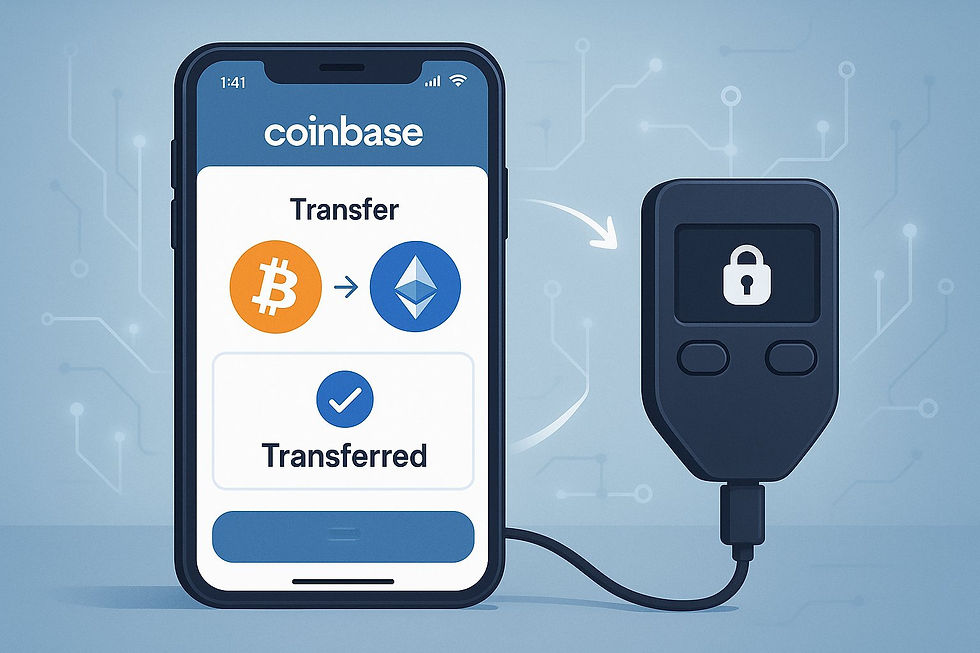How to Transfer Crypto from Coinbase to Coinbase Wallet: A Step-by-Step Guide
- The Master Sensei

- Sep 8
- 7 min read
Moving your cryptocurrency from a Coinbase account over to Coinbase Wallet gives you real control over your assets. Even though both platforms come from the same company, they have different uses and the transfer process isn’t quite as obvious as you’d hope.

You can transfer crypto from Coinbase to Coinbase Wallet using the app’s linking feature, which connects both accounts for quick, painless transfers—no need to mess with long, confusing addresses. This reduces the risk of sending coins to the wrong place and makes things a lot less stressful.
Getting a handle on the transfer steps lets you take advantage of self-custody while keeping your crypto within reach. If you want to use decentralized apps or just want more control over your coins, following these steps keeps your assets safe as you move them between platforms.
Essential Steps to Transfer Crypto from Coinbase to Coinbase Wallet
To move crypto between these platforms, you’ll need to link your accounts and follow some specific steps. You’ll prep both accounts, grab the right wallet address, start the transfer, and keep an eye on things as it moves.
Prepare Your Coinbase and Coinbase Wallet Accounts
Before you do anything, you’ll need to link your Coinbase account to your Coinbase Wallet app. This makes moving funds between the two a breeze.
The Coinbase Wallet app usually pops up a notification when the linking feature is ready. You can tap “Connect Now” or head to “Connect to Coinbase” in Settings.
Account Requirements:
Active Coinbase account with verified identity
Coinbase Wallet app installed on your phone
Enough crypto in your Coinbase account
Once you’ve linked them, you can transfer funds anytime from the Settings menu. This link acts as a direct bridge between the exchange and your personal wallet.
Make sure your account info is up to date before you start. If something’s outdated, it could hold up or even block the transfer.
Locate and Verify Your Wallet Address or QR Code
Every cryptocurrency has its own wallet address in Coinbase Wallet. You’ll need to find the right one for the coin you want to move.
Open Coinbase Wallet, pick the crypto you want, and the app shows your wallet address as both a string of letters and numbers and a QR code.
Address Verification Steps:
Open Coinbase Wallet app
Select the crypto you want to receive
Copy the wallet address or grab the QR code
Double-check that the address matches exactly
Ethereum and ERC-20 tokens use the same address, but Bitcoin needs its own. The QR code is handy—no need to type out long strings and risk mistakes. Just never share your private keys or seed phrase during this.
Initiate the Transfer Process on Coinbase
Log in to your Coinbase account and find the send option. Pick the crypto and amount you want to move.
Paste in your Coinbase Wallet address or scan the QR code. Coinbase will show you the network fee and an estimated arrival time before you confirm.
Transfer Steps:
Log into your Coinbase account
Click the “Send/Receive” button
Select “Send”
Pick the crypto and amount
Enter your Coinbase Wallet address
Review the transaction details
Check the transaction preview for fees and the final amount. Make sure everything looks right before you hit send.
Coinbase might ask for two-factor authentication or email confirmation for security. This keeps your funds safer.
Confirm Transaction and Track Transfer Status
After you review the details, hit send to broadcast the transaction to the blockchain. Coinbase gives you a transaction ID to track it.
Transfer times depend on the network and the crypto. Bitcoin usually takes 10–60 minutes, Ethereum is often faster—sometimes just a few minutes.
Tracking Options:
Transaction ID in your Coinbase account
Blockchain explorer sites
Coinbase Wallet transaction history
Email notifications from Coinbase
Keep an eye on your Coinbase transaction history or plug the transaction ID into a blockchain explorer to track progress. The funds show up in Coinbase Wallet once the network confirms everything.
Network fees come out of the amount you send, so factor that in when deciding how much to transfer.
Key Considerations and Best Practices for Secure Crypto Transfers
When you move crypto from Coinbase to Coinbase Wallet, you’ve got to pay attention to transaction costs, security, timing, and how this fits into your overall financial picture. Network fees can jump up and simple mistakes can mean losing your assets for good.
Understanding Network Fees and Transaction Timelines
Network fees matter—they’re what you pay miners to process your transaction on the blockchain.
Fee Structure and Timing:
Bitcoin transfers usually cost $1–$10, depending on how busy the network is
Ethereum fees can swing wildly, from $2 up to $50 or more at peak times
Confirmation times range from a few minutes to several hours
Check network conditions before you transfer. Fees and speeds tend to get worse on weekends or during big market moves.
Coinbase shows you the estimated fee before you confirm, and it picks a fee that should get your transaction processed at a reasonable speed.
Timing Strategies:
Send during off-peak hours to save on fees
Check blockchain congestion on fee tracking websites
Batch small transfers into one larger one if possible
Miners pick transactions with higher fees first, so timing can save you money if you’re patient.
Safeguarding Your Assets: Avoiding Common Mistakes
Even tiny mistakes during a transfer can cost you your crypto for good. Double-checking is key—there’s no undo button.
Critical Verification Steps:
Copy wallet addresses straight from the receiving wallet
Check the first and last few characters of the address
Pick the right network (Bitcoin, Ethereum, etc.)
Test with a small amount before sending a big one
Choosing the wrong network is the most common way people lose funds. Sending Bitcoin to an Ethereum address? It’s usually gone for good.
Don’t type addresses by hand. Use copy-paste, but remember, malware can mess with your clipboard.
Security Checklist:
Use a secure internet connection
Turn on two-factor authentication everywhere
Keep your software updated
Store backup phrases somewhere safe, not online
Watch out for scammers—they sometimes send fake addresses that look almost right. Visually confirm everything before you send.
Connecting to the Crypto Ecosystem Beyond Coinbase
Once your crypto’s in Coinbase Wallet, you can use decentralized apps and services you can’t touch from a regular exchange. But with more power comes more responsibility.
Ecosystem Access Benefits:
Use DeFi protocols directly
Buy, sell, or mint NFTs
Access new tokens before they hit exchanges
Hold your own private keys—real ownership
Coinbase Wallet connects to thousands of decentralized apps across different blockchains. You get access to lending, trading, and even governance.
But the decentralized world isn’t like traditional finance. Almost every action has a fee, and you’re in charge of your own security.
Ecosystem Navigation:
Research apps before connecting your wallet
Watch out for smart contract risks
Keep an eye on gas fees, especially for complex actions
Hold some native tokens (like ETH) to pay transaction fees
DeFi can offer higher yields than banks, but it’s riskier—smart contract bugs and price swings can wipe out gains.
Implications for Your Bank Account and Exchange Use
Moving crypto to your own wallet changes how you interact with banks and exchanges. Tax reporting gets trickier, too.
Banking Considerations:
Wallet transfers usually don’t show up in exchange tax reports
You’ll need to keep your own records for taxes
Banks might flag accounts with lots of crypto activity
It’s harder to prove where funds came from if you move large amounts
Banks sometimes flag or question accounts with lots of crypto movement. Having funds in a personal wallet instead of an exchange can make it tougher to show where your money came from.
Exchange Strategy:
Keep some funds on exchanges for quick trading
Use wallets for long-term storage and DeFi
Document every transfer between platforms
Think about timing for taxes
Frequent transfers between exchanges and wallets can trigger taxable events, depending on where you live. It’s smart to check with a tax pro about what you need to report.
Some banks watch or restrict crypto transactions. Keeping detailed records helps if you ever need to explain your activity to a bank or tax office.

Frequently Asked Questions (FAQs)
Most people just want simple steps for moving crypto between Coinbase and Coinbase Wallet—and they want to avoid extra fees. Linking accounts and fixing failed transfers trips up both beginners and experienced folks.
What are the steps to move cryptocurrency from Coinbase to a Coinbase Wallet?
First, link your Coinbase.com account to your Coinbase Wallet app in the settings menu. Tap “Connect to Coinbase” and follow the on-screen prompts.
Once linked, go to the settings menu in Coinbase Wallet, pick the transfer option, and select the crypto you want to move.
Enter how much you want to send and confirm. The crypto moves from your Coinbase account to your Wallet—usually within a few minutes.
Is there a way to transfer digital assets from Coinbase to Coinbase Wallet without incurring any fees?
Coinbase lets you transfer assets from Coinbase.com to Coinbase Wallet without extra fees, as long as you use their built-in feature. This skips the blockchain and keeps things internal, so no network fees for these moves.
Just make sure both accounts are linked correctly. If you later send crypto from Coinbase Wallet to an external address, you’ll pay network fees then. The fee-free perk only covers transfers within Coinbase’s own products.
Can you guide me through the process of sending XRP to my Coinbase Wallet from Coinbase?
For XRP, it’s the same process as other supported coins. Link your Coinbase account to Coinbase Wallet in settings.
After linking, choose XRP in your Coinbase account, enter the amount, and start the transfer to your Wallet.
Check the details, confirm, and your XRP shows up in Coinbase Wallet once the internal transfer is done.
How do I connect my Coinbase account to the Coinbase Wallet app?
Open Coinbase Wallet and look for a notification about connecting your account. Tap “Connect Now” if you see it.
If not, open settings in the Wallet app and choose “Connect to Coinbase.”
The app walks you through authentication—just log in to your Coinbase.com account to finish linking.
What should I do if my transfer from Coinbase Wallet to Coinbase is not showing up?
First, make sure you sent the crypto to the right Coinbase account address. Check the transaction hash on a blockchain explorer for that coin.
Sometimes, network congestion slows things down. Wait for a few more confirmation blocks before you panic.
If the transaction is confirmed on the blockchain but not showing in Coinbase, reach out to Coinbase support with your transaction hash and account info.
How can I transfer my USD Coin (USDC) from my Coinbase Wallet back to Coinbase?
If you want to move USDC from your Coinbase Wallet to your Coinbase account, just use the send function. First, grab your Coinbase USDC receiving address from your account.
Open your Coinbase Wallet, tap on your USDC balance, and hit send. Paste your Coinbase USDC deposit address as the recipient.
Type in the amount of USDC you want to transfer, then confirm it. Keep in mind, you'll have to pay a network fee for this blockchain transaction.
















































Comments